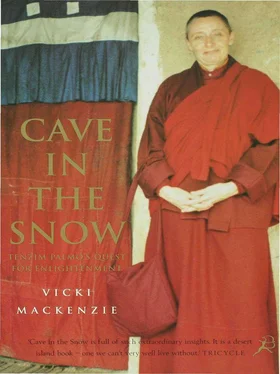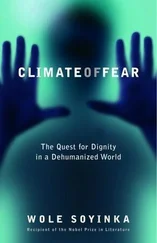Adding to her general misery was her challenging relationship with Choegyal Rinpoche, the monk put in charge of teaching her Buddhism. He was an interesting man. A few years younger than Tenzin Palmo, he had been closely associated with all the Khamtrul Rinpoches (and therefore by association with Tenzin Palmo too). Choegyal Rinpoche was not only an acknowledged lineage master, also in his eighth reincarnation, but was an acclaimed artist too. He had had a particularly traumatic escape out of Tibet aged just thirteen, having been captured and then released by a Tibetan ’Red Guard’ who happened to recognize him beneath his disguise. This experience together with the trauma of seeing his monastery with its works of art destroyed made him highly strung and difficult for Tenzin Palmo to deal with.
‘Our relationship was both close and exceedingly fraught. Actually I saw him as a Taoist sage living on a mountain painting the moon,’ she said. ‘I got affected by his temperament. He was quite erratic and neurotic, so that I never knew where I stood with him. Frankly, it was one of the most difficult relationships that I have ever had. I felt it had to be karmic, something that had to be resolved in this lifetime.’ She begged Khamtrul Rinpoche to give her someone else to instruct her, but he declined. ‘No, Choegyal Rinpoche is your teacher,’ he insisted.
Her alienation was exacerbated by the fact that she could neither speak the language well nor read the texts, Snellgrove’s lessons back in London being very rudimentary. ‘I would have to look up every word in the page. It took ages. And nobody spoke English. Choegyal and I would communicate in “Tiblish”. That was the thing with Khamtrul Rinpoche. He wasn’t a hip lama who wanted to attract a large group of Western followers. If you wanted to be with him you had to learn Tibetan and do it his way.’
Eventually she would be able to hold prolonged conversations in Tibetan and read the texts fluently, actually preferring them to the translations, which, she said, lost nearly all of the poetry and the soaring inspirational flavour of the originals. But for now gaining meaning from the unfamiliar script was a decided ordeal.
Tenzin Palmo went along with it all for a long time – the discrimination, the prejudice, the put-downs. There was no one to advise her otherwise. She had never heard of women’s lib, never seen any bra-burning, had never read Germaine Greer’s revolutionary words in the Female Eunuch : ‘Women have very little idea of how much men hate them.’ She had left England long before all that had happened. More specifically, there were no women gurus to turn to for help.
‘It was only gradually that I began to think, no, wait a minute, this isn’t right, and to feel very sad,’ she said. It all reached a crescendo at one significant point in time. It was then that Tenzin Palmo made the vow that was to inspire hundreds of women across the world when they later heard of it. The vow to attain Enlightenment as a woman.
‘It was a moment of sheer frustration after I’d been rejected yet again on account of being female. I made this heartfelt pledge: I’m going to continue to take female form and achieve Enlightenment!’ she said, puffing with indignation. ‘I was so exasperated by this terrible male chauvinism that was all around me. I thought, “Forget it! I don’t want to be born in a male body under these circumstances.” And so I made this strong prayer; even if I can’t do that much in this lifetime, in the future may this stream of consciousness go forward and take on the transitory form of a female rather than a male.’
She was not being particularly militant about it. It was simply that the balance of power on the spiritual front had to be redressed. ‘Of course being male or female is all relative, but at this moment we are living on a relative plane and the point is that there is such a great dearth of female spiritual teachers. So at this time being a female is more helpful,’ she said simply.
The gloom was punctuated by small moments of light. About a year after Tenzin Palmo had been living in Dalhousie, the indomitable Lee travelled out to see her daughter. ‘I wish I could do something meaningful with my life,’ she had written to her. ‘Well, in that case why don’t you sell your house and come and meet the lamas?’ Tenzin Palmo had replied. Lee did just that and duly arrived in Dalhousie, carrying tapes of Bob Dylan in an effort to update Tenzin Palmo with Western culture. She loved everything about India, the way of life, the Tibetans, the Buddhist doctrine, and decided to take Refuge with Khamtrul Rinpoche, thereby committing herself officially to the Buddhist path, as her daughter had done. On the morning of the ceremony, while she was still in bed, she had a vision of Tara, the female Buddha of compassionate action, smiling beatifically at her and handing her a flower.
’She had a wonderful time and wanted to live in India permanently,’ said Tenzin Palmo, ‘but she couldn’t take the food, the climate and the lack of comfort so after ten months she went back to England.’
Life went on. There was the Saturday night excursion to the Bengali sweet shop for the syrupy gulab jamuns and the occasional picnic, which in typical Tibetan style sometimes went on for days and days. There was one famous picnic which started off at three days, went on for ten, and then stretched to twenty. The food might have been very poor but the Tibetans’ capacity for fun was still intact.
When, one day in 1967, she suddenly got an unexpected windfall of 400 rupees (about £8), Tenzin Palmo made the journey to Sikkim, on the other side of India, to receive her full ordination from the Karmapa, head of the Kargyu sect and a close friend of Khamtrul Rinpoche. It was the formal admittance into the monastic assembly, poetically called ’The Going Forth’ – referring to the going forth into homelessness, which in Tenzin Palmo’s case had already been enacted. She would have liked Khamtrul Rinpoche to perform the ritual, but he had not been formally ordained himself for the prerequisite ten years and she didn’t want to wait any longer.
The ceremony itself was memorable. During the proceedings the Karmapa leant down and whispered in her ear: ‘You’re the first Western nun that I’ve ordained. You’ve never been married, you’ve never had children, therefore there is more temptation for you to fall. You must be very strong and very careful. We Tibetans believe the founding of any movement or institution is of great importance for the future. In the years to come there will be many, many who will ordain. Whatever happens, you must never give up your ordination.’ The responsibility really struck home.
When it was all over Tenzin Palmo returned to her room and collapsed into bed. It had been a long day; the ceremony had lasted almost three hours and had been conducted entirely in Tibetan. She immediately fell asleep, only to be awoken by a loud banging on the door and a voice shouting, ‘Usha coming, Usha coming.’
‘I leapt out of bed and dashed back to the monastery, thinking someone important was about to arrive. When I got there I found the Karmapa in a side room, sitting on a high throne with a hat box in front of him. At that moment I realized that “Usha” was the honorific name for “hat” and that the Karmapa was going to perform the black hat ceremony.’
Tenzin Palmo was about to be privy to one of the most mystic and powerful rituals that existed in Tibetan Buddhism. Said to be made from the hair of 100,000 Dakinis (powerful female spirits), the black hat or crown was regarded as a mystic object of awesome power. It was believed to be self-existent over the head of all the Karmapas, visible to those whose sight was pure enough to see it, and was held to be capable of liberating on sight.
Читать дальше












